About China’s “Intelligence Satellites”...
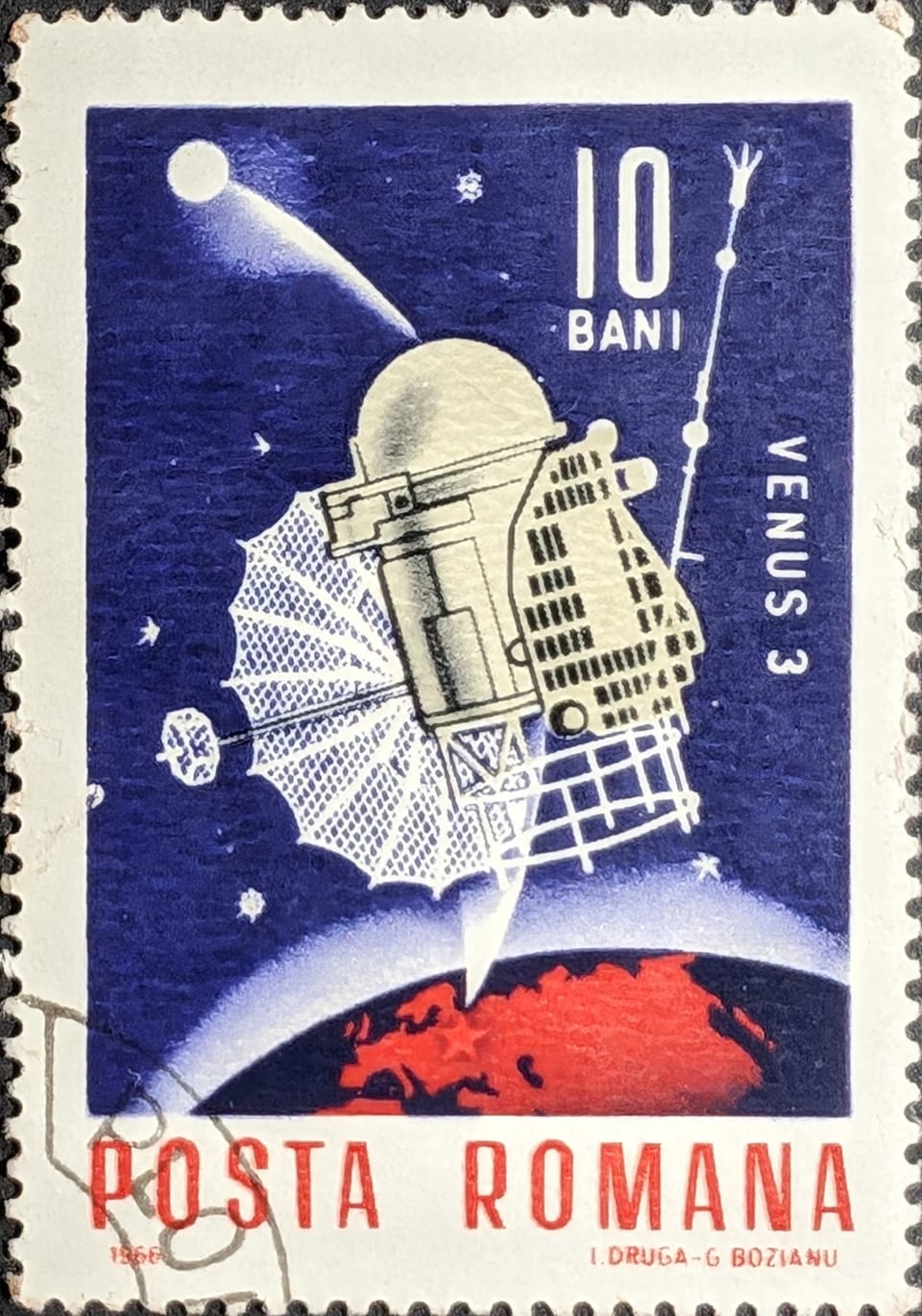
Are you interested in U.S. lunar activities and wonder about humanity’s future on the Moon? If so, you might appreciate reading my article for Astralytical: Lunar Learning, Infrastructure, and Experience.
Last week, a U.S. Space Command general provided some dire warnings about satellite growth and increased space capabilities from China and Russia. According to the article, the general made the claim that:
[a]s of January 2024, the PRC has deployed a fleet of 359 intelligence satellites, Whiting said, “more than tripling its on-orbit collection presence since 2018.”
That’s an interesting statement because it’s definite. It sounds ominous because it involves China, and 359 intelligence satellites sound like a lot.
What is an Intelligence Satellite?
Considering China’s deployment of 359 satellites from 2018 through 2023, it averages an impressive-sounding number of nearly 72 intelligence satellites annually. But the number of satellites the general mentioned–359–looks inaccurate. He may have added up satellites conducting civil and military missions instead of military only (I usually don’t consider civil satellites as intelligence satellites).
My database shows about 177 satellites if I add up China’s civil and military spacecraft that might fit an intelligence role for that timeframe–a little short of the 359. China’s space operators increased civil and military “intelligence” spacecraft deployments from 2018 through 2023 (graph below). However, 2023’s deployments from China are merely double its 2018 spacecraft deployments. U.S. intelligence spacecraft deployments seem low, though.
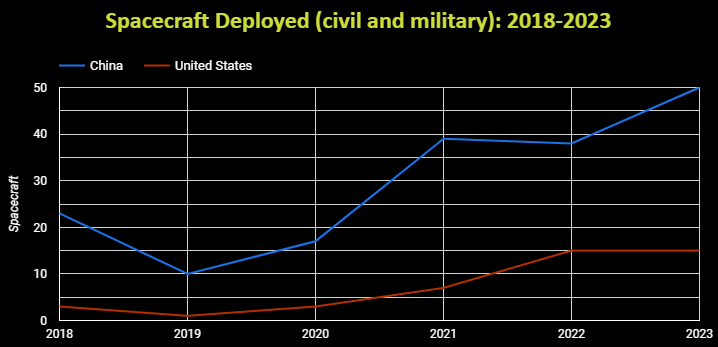
If I include all military and civil spacecraft, not just those ideal for reconnaissance roles, the number goes to 338. To be clear, I rely on the same baseline spacecraft data the general relies on–the U.S. military’s Space-Track (I suspect his intelligence briefing is more comprehensive, however).
Can the discrepancy be accounted for if the general included commercial satellite deployments? When I add commercial satellites from China, however, it goes way over–752 satellites in total from China. That is nearly double the general’s number. However, it does sound more dire and valuable if he intended to show more spacecraft deployments from China from 2019 through 2023. Still, both his number (whatever spacecraft that encompasses) and mine, which includes all spacecraft deployments from China, sound significant.
That seeming significance is why the following graph is necessary.
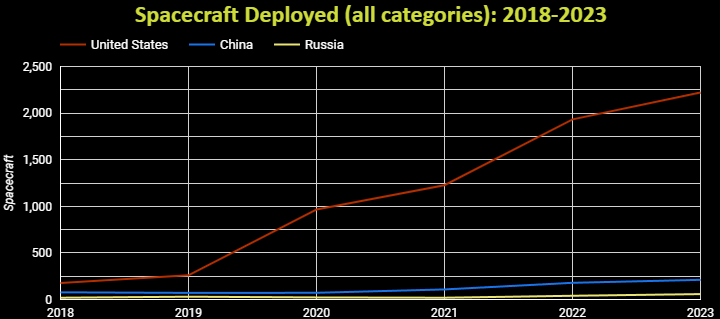
Aren’t comparisons fantastic?
Suddenly, China’s intelligence satellite deployment total doesn’t look very impressive. Starting in 2020, annual U.S. spacecraft deployments exceeded China’s four-year deployment total. The U.S. yearly spacecraft deployment average from 2019 through 2023 was over 1,600.
Define Breathtaking
But the general is super worried about China:
“growing its military space and counterspace capabilities at breathtaking pace to deny American and Allied space capabilities when they so choose,” Whiting said, “while extending its ability to conduct long-range fires improving the precision and reach, thus the lethality, of its terrestrial forces.”
However, perhaps the general implies that all of China’s civil and military spacecraft deployments are intelligence-related. If that’s the case, the graph looks a little more interesting.
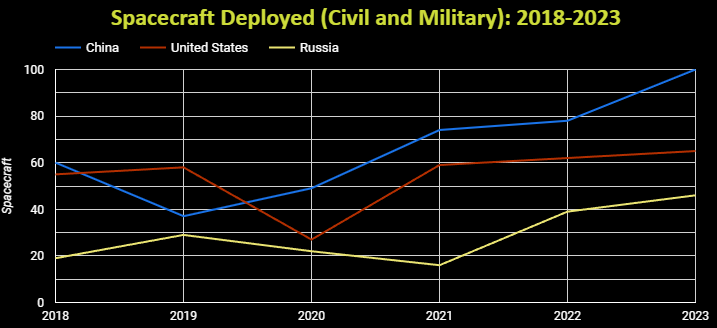
Whoa! That’s a lot less spacecraft to count.
It looks as if China’s spacecraft deployments did increase during that time. But they didn’t triple as the general claimed. China’s space operators deployed about 60 civil and military spacecraft in 2018. In 2023, they deployed 100, a 67% increase. It’s an increase, but is it a breathtaking increase? Maybe, if he provided this information in a vacuum.
What is interesting to see is that U.S. civil and military deployments stayed pretty level. The 2020 dip is likely because of the global pandemic, but the average annual deployment rate for U.S. civil and military satellites was 65. The upshot from the data is that U.S. civil and military spacecraft deployments were below those of China’s space operators for four out of five years.
So, yes, China’s civil and military spacecraft deployments are ahead of U.S. spacecraft deployments. In 2023, China’s spacecraft operators deployed 35 more civil and military spacecraft than U.S. spacecraft operators, the highest of the 2018-2023 span. While China’s civil and military spacecraft deployments are moving ahead of U.S. spacecraft deployments, they are far from growing at a “breathtaking pace.”
The gap should concern U.S. Space Command, perhaps enough to move more quickly towards newer spacecraft acquisition processes. However, the spacecraft gap still doesn’t back the general’s statistics. Maybe he was thinking along the lines of spacecraft mass deployed into orbit?
The amount of mass a nation’s space operators can deploy into orbit, especially for civil and military missions, demonstrates a focus more on mission capabilities and less on compromises. Some compromises still exist, but a higher-mass satellite is theoretically more capable and longer-lasting than a 3U cubesat (unless a nation’s satellite manufacturers rely on consumer-grade refrigerator boards).
If, in 2023, China’s space operators deployed three times the mass that they did in 2018, there’s reason for concern. However, that also doesn’t appear to be the case.
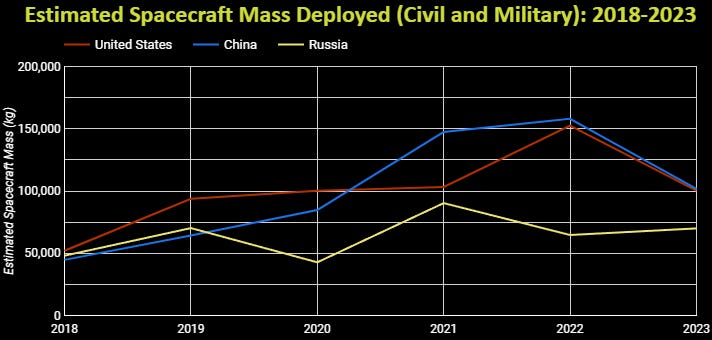
A word about military spacecraft deployments and mass specifically: a nation’s military doesn’t like to provide information of any kind that provides even a hint at what a spacecraft can do. And so, nice-to-have tidbits such as spacecraft mass are state secrets. Classification rules and procedures mean that unless people are willing to break those laws and risk their clearance, all unofficial military spacecraft numbers are unavailable, requiring guesses. Hence, liberal use of the word “estimate.”
The estimated U.S. and China spacecraft mass deployments to orbit tended to swap with each other. The last two years show almost equal deployments of mass. Russia, too, deployed significant mass, likely due to its Soyuz Progress and MS missions. China’s space operators tripled the mass deployed to orbit in 2018–but so did the U.S. They both did so by 2022, not 2023. This tripling could be what the general meant.
But he didn’t say that. And he probably wouldn’t have meant to because using those numbers would have required explanations similar to what I just had to write. Since part of his audience was lawmakers, he probably would have had to use much smaller words.
Growth, but Not Fast and Not Triple
So, China’s spacecraft operators have deployed nearly equal amounts of mass to orbit as U.S. spacecraft operators. They’ve done this while deploying slightly greater numbers of spacecraft from China, indicating more of their civil and military spacecraft are smaller mass when compared with their U.S. counterparts. However, U.S. operators of commercial spacecraft are deploying a ridiculous number of spacecraft and mass compared to civil and military space operators from both nations.
That should be unsurprising, not just because of SpaceX’s Starlink deployments. The U.S. space industry, especially its military and civil agencies, has desired more commercial alternatives for spacecraft. They have tried a few initiatives to foster commercial growth. The growth rate of U.S. commercial spacecraft deployments over five years indicates some impacts from those initiatives.
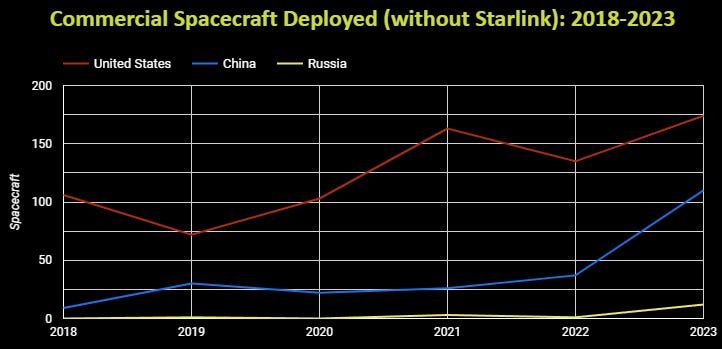
China’s commercial spacecraft deployments are growing but still below U.S. spacecraft deployments. In 2023, China’s commercial space operators deployed not triple but ten times the number of commercial spacecraft they deployed in 2018. However, based on the numbers, it’s unlikely the general was referring to China’s commercial spacecraft sector.
This analysis returns to the question of what intelligence satellites the general’s numbers refer to. He needs to define what he is saying. He’s trying to relay that U.S. military space activities should receive more funding. But the Space-Track data, combined with my data (almost all from primary sources), don’t support the notion of China’s speedy growth in the space realm.
The data does show, however, that despite the billions the U.S. DoD continues to invest in space technology, the deployments of military spacecraft (especially U.S. intelligence satellites) have not increased. That will change, primarily due to Space Development Agency efforts but will not match or exceed commercial deployments. It also shows that Russian spacecraft deployments have far to go before catching up with China.
But China’s space activities, while interesting, aren’t near as threatening to U.S. military space supremacy as the general seems to believe. Add on commercial spacecraft deployments from U.S. operators (which U.S. military agencies are leveraging), and the worry about intelligence satellites–however he defines that category–seems contrived.
If you liked this article (or any others from Ill-Defined Space), any donations are appreciated. For the subscribers who have donated—THANK YOU!!




Comments ()